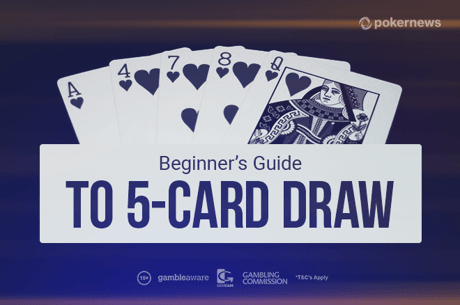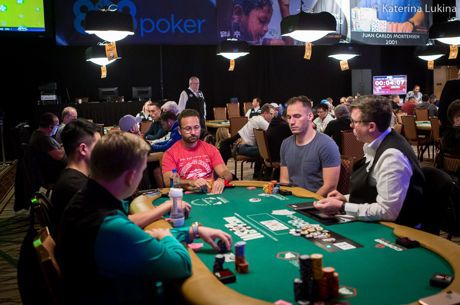Thinking Outside the Hold’em Box: No-Limit Deuce-to-Seven Single Draw

In this series, I am discussing some of the poker variants other than no-limit hold'em you'll probably hear about during coverage of this year's World Series of Poker. If a game piques your interest, think about taking some time to explore it further. Who knows — you just might find a new game to love!
No-Limit 2-7 Single Draw
This year’s $1,500 No-Limit 2-7 Single Draw event is just around the corner, coming Tuesday, June 9 (Event #23). In 2012, this event made its debut, with Larry Wright taking the title. After a one-year hiatus, the event returned last year and Steven Wolansky emerged as the winner from a field of 241 players, defeating 2010 November Niner Joseph Cheong heads-up to win his first gold bracelet. Perhaps one of the more intriguing stories of that event, however, revolved around German footballer Max Kruse.
Kruse, who took the opportunity to play at the WSOP after being unexpectedly left off the German 2014 World Cup roster, reportedly only learned the game from George Danzer shortly before the event's start. Despite such brief instruction, the football star managed to dribble past nearly all his opponents before settling for a highly respectable third-place finish.
We were also treated to another memorable finish in last year's $10,000 No-Limit 2-7 Single Draw event, where eventual winner Paul Volpe denied Daniel Negreanu a seventh WSOP title. For many of the viewers who were following that bracelet run, it may have been their first introduction to this interesting but rarely spread variant often touted as being among the purest forms of poker. This year's $10,000 No-Limit 2-7 Single Draw Championship is also coming up soon, starting on Saturday, June 13 (Event #29).
As a draw variant, there are no cards shown in no-limit 2-7 single draw, so there is no way of knowing exactly what cards your opponents are holding during the hand. Further, as the name of the game suggests, there is only one available draw; therefore, the only concrete information giving a hint of what cards an opponent might hold is the number of cards drawn on that single draw.
These factors make no-limit 2-7 single draw a game highly conducive to bluffing. When played at a high level, poker becomes less about relying on the absolute strength of hands, and more about exploiting your opponents' tendencies.
Psychology becomes a very important factor, and players may find themselves routinely asking: Does my opponent really have a better hand or not? And as with any game having a no-limit betting structure, big pots can be potentially won or lost depending on the accuracy of the read.
Hand Rankings
The object of no-limit 2-7 single draw is to make the lowest five-card hand possible. However, unlike the game of razz (discussed in my previous article), which has the same objective, the hand ranking system used is different. Getting accustomed to a different ranking system can be initially challenging for newcomers to this variant.
In "deuce-to-seven" games, the Ax always plays as a high, undesirable card. Also, straights and flushes are valid hands, but because they are strong hands in high hand ranking systems, they are unwanted in 2-7 games whose objective is to make the lowest possible hand. Thus, those count against you.
Accordingly, the best hand in this game consists of the cards 2x3x4x5x7x, with at least two suits represented (i.e., not a flush) — hence the modifier "deuce-to-seven." This hand is made up of the five lowest-ranked cards that do not form a straight.
In lowball games such as no-limit 2-7 single draw, the highest-ranked cards of a hand determine its rank. Therefore — assuming the hand does not contain a straight, flush, or any pairs — when determining the rank of a hand, the cards should be ordered from highest to lowest to facilitate reading of the hand. Consider the following examples of 2-7 hands (ordered from strongest to weakest):
- 7♦5♦4♠3♥2♣ — 7-high hand
- 8♣6♥5♣4♣3♣ — 8-high hand
- 9♣7♦6♥4♥3♥ — 9-high hand
- A♠7♥6♠5♠2♦ — ace-high hand
- 3♠3♥7♣4♦2♥ — pair of threes
- 7♠6♦5♦4♣3♣ — straight
- 8♥6♥5♥4♥2♥ — flush
Play of the Hand
In no-limit 2-7 single draw, players are dealt five cards each. Then there are two betting rounds, with no limit on the size of bets and raises, and one opportunity to draw. Players can draw any number of cards up to five or "stand pat" (drawing none) in between those betting rounds.
Note that in addition to blinds, antes are also typically posted to encourage action prior to the opening betting round. Further, although some venues do not enforce this traditional rule, the first player to enter the pot after the blinds must come in for at least a minimum raise (i.e., no open-limping).
Basic Strategy Tips for 2-7 NL Single Draw
In general, you prefer to start with either a good low hand, or be drawing one card to a good low hand. It is particularly difficult to improve to a strong low hand after drawing two cards. Therefore, if you are still learning the game you may find hands easier to play if you simply avoid playing such two-card draws, especially when you expect to be out of position.
Position is of critical importance in draw games. Being in position allows you to see how many cards your opponents are drawing before making your own drawing decision, and to see whether your opponents have checked or bet (and how much) before it is your turn to act on the final betting round. This may allow you to take advantage of the natural tendency of many players to check whenever they have missed their draws.
So then, what constitutes a "good" low hand? For a better sense of the range of hands that can be made in single draw, it is instructive to think about the number of hands of different possible strengths that can be made in a 2-7 ranking system:
| 7-high: | 4 hands (from 7-5-4-3-2 to 7-6-5-4-2) |
| 8-high: | 14 hands (from 8-5-4-3-2 to 8-7-6-5-3) |
| 9-high: | 34 hands (from 9-5-4-3-2 to 9-8-7-6-4) |
| 10-high: | 69 hands (from T-5-4-3-2 to T-9-8-7-5) |
| J-high: | 125 hands (from J-5-4-3-2 to J-T-9-8-6) |
| Q-high: | 209 hands (from Q-5-4-3-2 to Q-J-T-9-7) |
Note the number of hands falling into any given group increases exponentially as the rank of the hands in the group increases. For example, there are more combinations of 10-high hands possible than all nine-high-or-better hands combined, and more jack-high hands possible than all 10-high-or-better hands combined.
In absolute terms, all made seven-high and eight-high hands are very strong, as are many of the best nine-high hands, and all can usually be played aggressively on the final betting round.
Weaker nine-high hands and 10-high hands are still quite good, and will win a decent share of pots. They hold up particularly well in short-handed situations.

Jack-high hands are generally considered average, and in many situations you will likely be trying to get to showdown cheaply with these hands. Although, when bet into by an opponent who tends to bet only with stronger hands, folding jack-high hands (and possibly even better hands depending on that opponent's tendencies) will usually not be a big mistake. That said, it can definitely be a mistake to fold these hands too often, however — particularly in heads-up situations — as they are still quite difficult to make.
Be aware that whenever a player is drawing one card, even with a draw as strong as 7x4x3x2xXx, a jack-high hand will be made about half the time. But this also means a hand worse than jack high will be made about half the time. It is quite difficult to make very strong hands with the benefit of only a single draw.
With this in mind, let's suppose you will always fold to a bet whenever you fail to make a J-high or better hand after drawing. Opponents who have figured this out would be well served to bet out every time after the draw if you did not stand pat.
They are betting solely on the possibility you did not improve to a hand you would be willing to show down. They could do this even from out of position, knowing you would fold whenever your draw missed. This is why it is critical to assess the tendencies of your opponents accurately, and to adapt accordingly.
For example, in heads-up situations, if your opponent is apt to bet frequently as a bluff after missing a draw, then you should be prepared to adjust by showing down more weaker-than-average hands (e.g., queen-high, king-high, or ace-high hands), which you might have folded against less bluff-prone opponents, to avoid being exploited.
Conversely, if you sense your opponent is playing very tight post-draw, strictly calling with only jack-high-or-better hands (some opponents may have even tighter calling requirements), then you can exploit this tendency by attempting bluffs with failed draws yourself more frequently, particularly when in position and your opponent checks to you after drawing one or more cards.
For example, with your worst missed draws that have little showdown value — say you've drawn a big pair or a straight — you could attempt a bluff against tight opponents: they will rarely improve to very strong hands, and will fold often.
Ken Lo is the author of A Poker Player’s Guide to Mixed Games: Core Strategies for HORSE, Eight-Game, Ten-Game, and Twelve-Game Mixes. He is based in Toronto, Canada. Follow him on Twitter @ppgmg.
Want to stay atop all the latest in the poker world? If so, make sure to get PokerNews updates on your social media outlets. Follow us on Twitter and find us on both Facebook and Google+!









